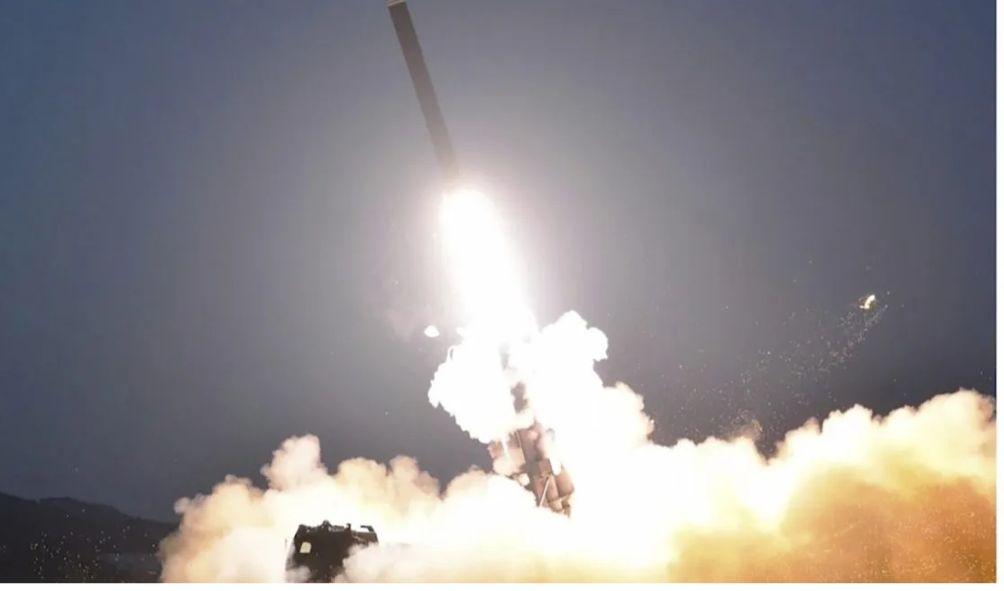North Korea Fires 2 Missiles Amid US-South Korea Drill
Tuesday, according to the South Korean military, North Korea fired two short-range ballistic missiles into the sea in response to ongoing U.S.-South Korean military exercises on the Korean Peninsula.
The launches occurred minutes apart from one another. At approximately 7:41 a.m. (local time), the Joint Chiefs of Staff (JCS) of South Korea detected North Korea launching a missile from the Jangyon region of South Hwanghae province, followed by another launch at 7:51 a.m. (local time).
South Korea did not specify the range of the missiles.
Yonhap News Agency (YNA) reported that the JCS stated it would maintain “a full readiness posture” with the United States against the possibility of additional launches from North Korea.
The most recent launches occurred just two days after North Korea claimed to have launched two strategic cruise missiles from a submarine on Sunday, a day before U.S.-South Korea military drills were scheduled to commence.
North Korea Fires 2 Missiles Amid US-South Korea Drill. The cruise missiles were launched from a submarine named “8.24 Yongung” and traveled approximately 1,500 kilometers (932 miles) before striking a target in the East Sea, according to North Korea’s state-run Korean Central News Agency (KCNA).
KCNA reported that the exercise “confirmed the reliability of the weapon system and examined the underwater-to-surface offensive operations of the submarine units” as part of North Korea’s nuclear deterrent program.
Extremely Important Drills
Monday marked the start of the 11-day Freedom Shield exercise between South Korea and the United States, which includes field exercises on a scale not seen since 2017 when the two allies scaled back public drills to facilitate talks with North Korea.
In an interview with Yonhap on March 12, Lt. Gen. Andrew Harrison, the deputy commander of the United Nations Command, stated, “This routine training exercise is incredibly important for readiness.”
During the drills, personnel from the “sending states” will practice crisis management and other contingency procedures, as they did at the beginning of the Korean War when they sent forces to support South Korea. The communist North and democratic South Korea are technically still at war without a peace treaty.
“In the early stages of an exercise, we examine potential challenges to the armistice and attempt to de-escalate to a pre-crisis position,” he explained.
“If the crisis escalates into a conflict, we are examining how the sending states could work together in any scenario,” Harrison said.
The United States and South Korea claim that their joint military exercises are defensive, but North Korea views them as “an invasion rehearsal” and has threatened “unprecedented” retaliation.
Kim Yo Jong, the sister of North Korean leader Kim Jong Un, previously stated that any attempt to intercept North Korea’s missile tests would be viewed as a “declaration of war” against the reclusive nation.
She asserted that the DPRK would be compelled to take action in response to the frantic U.S. and South Korean military maneuvers and rhetoric.
The United States capitalizes on “Every Leg of the Nuclear Triad.”
General Anthony Cotton, the commander of U.S. Strategic Command, stated last week that the United States would utilize its nuclear triad to defend South Korea from North Korean aggression.
ALSO READ: China to reopen borders to foreign tourists
Nuclear-capable heavy bombers, long-range ballistic missiles, and nuclear-armed submarines are the three components of the U.S. nuclear triad.
Cotton told the Senate Committee on Armed Services on March 9 that North Korea continues to pose a threat to the United States and its allies.
“We are recapitalizing each leg of the nuclear triad and the nuclear command, control, and communication systems to ensure our continued ability to serve as the foundation of integrated deterrence,” he added.
Last year, North Korea launched several missiles, including its largest intercontinental ballistic missile, the Hwasong-17, all of which are prohibited by U.N. Security Council resolutions regarding North Korea’s missile program.
North Korea has rejected the United States’ efforts to engage in “direct talks” without preconditions to reach a diplomatic solution.
HEY READER. PLEASE SUPPORT THIS SITE BY CLICKING ADS. DON’T FORGET TO HIT THE NOTIFICATION BELL FOR MORE UPDATES AROUND THE GLOBE.
